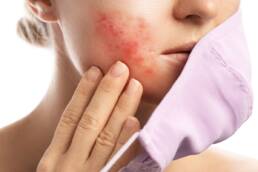May is Melanoma Awareness Month, a time to educate yourself and others about skin cancer, particularly melanoma, the deadliest form of skin cancer. At Skin Brava, we’re committed to empowering you with knowledge to protect your skin and recognize warning signs early. In this blog, we’ll explore how to prevent melanoma, raise skin cancer awareness, use the ABCDE criteria to identify potential melanomas, and highlight triggers that should prompt a visit to a dermatologist. By staying informed, you can take charge of your skin health and reduce your risk.
What Is Melanoma and Why Is Awareness Important?
Melanoma is a type of skin cancer that develops in melanocytes, the cells responsible for producing pigment in your skin. While it’s less common than other skin cancers like basal cell or squamous cell carcinoma, melanoma is far more dangerous because it can spread to other parts of the body if not detected early. According to the American Cancer Society, over 100,000 new melanoma cases are diagnosed annually in the U.S., and early detection is critical for successful treatment.
Melanoma Awareness Month, observed every May, aims to educate the public about the risks, prevention, and early detection of melanoma. By spreading awareness, we can encourage proactive steps to protect skin health and save lives. At Skin Brava, we believe knowledge is power, and understanding melanoma is the first step toward prevention.
How to Prevent Melanoma: Practical Tips for Skin Protection
Preventing melanoma starts with adopting habits that shield your skin from damage, particularly from ultraviolet (UV) rays, a leading cause of skin cancer. Here are actionable steps to reduce your risk:
- Wear Sunscreen Year-Round
Sunscreen is your first line of defense against UV rays. Choose a broad-spectrum sunscreen with at least SPF 30 and apply it generously to all exposed skin, even on cloudy days. Reapply every two hours, especially if you’re swimming or sweating. Skin Brava offers a range of high-quality sunscreens designed to protect and nourish your skin—check them out here. - Seek Shade During Peak Hours
UV rays are strongest between 10 a.m. and 4 p.m. When possible, stay in the shade during these hours, especially in sunny climates. Use umbrellas, hats, or shaded areas to minimize direct sun exposure. - Wear Protective Clothing
Covering your skin with clothing is an effective way to block UV rays. Opt for long-sleeved shirts, wide-brimmed hats, and UV-protective sunglasses. Fabrics with a tight weave or UPF (Ultraviolet Protection Factor) ratings offer the best protection. - Avoid Tanning Beds
Tanning beds expose your skin to intense UV radiation, significantly increasing your melanoma risk. The World Health Organization classifies tanning beds as carcinogenic, so skip them entirely and embrace your natural skin tone. - Perform Regular Skin Checks
Examine your skin monthly for new or changing moles, spots, or growths. Early detection is key to catching melanoma before it spreads. Use a mirror or ask a partner to check hard-to-see areas like your back. - Maintain a Healthy Lifestyle
A strong immune system supports overall health, including your skin. Eat a balanced diet rich in antioxidants, stay hydrated, and avoid smoking, which can weaken your skin’s defenses.
By incorporating these habits into your routine, you can significantly lower your risk of developing melanoma. Visit Skin Brava for skincare products that complement your prevention efforts.
Raising Skin Cancer Awareness: Why It Matters
Skin cancer is the most common cancer in the United States, yet many people underestimate its seriousness. Melanoma Awareness Month is an opportunity to spread the word about the importance of skin health. Here’s how you can contribute:
- Share Information: Post about melanoma prevention and early detection on social media. Use hashtags like #MelanomaAwarenessMonth and #SkinCancerAwareness to reach a wider audience.
- Educate Your Community: Talk to friends and family about the risks of UV exposure and the importance of regular skin checks.
Support Organizations: Donate to or volunteer with organizations like the Skin Cancer Foundation or the American Academy of Dermatology to fund research and education.
Raising awareness helps dispel myths, like the idea that only fair-skinned people are at risk. Melanoma can affect anyone, regardless of skin tone, so everyone should prioritize skin protection.
The ABCDE Criteria: How to Identify Melanoma
Early detection of melanoma can be life-saving, and the ABCDE criteria is a simple tool to help you spot suspicious moles or growths. Here’s what each letter stands for:
A: Asymmetry
One half of the mole or spot doesn’t match the other half. If you draw an imaginary line through the center, the two sides should look similar. Asymmetrical growths may indicate melanoma.
B: Border
Healthy moles typically have smooth, even borders. Melanomas often have irregular, jagged, or blurred edges. Pay attention to any mole with uneven borders.
C: Color
Benign moles are usually a single color, often brown or black. Melanomas may have multiple colors, including shades of brown, black, red, white, or blue. Variegated colors are a red flag.
D: Diameter
Melanomas are often larger than 6 millimeters (about the size of a pencil eraser), though they can be smaller. Any growth larger than this warrants closer inspection.
E: Evolving
Any change in a mole’s size, shape, color, or symptoms (like itching or bleeding) is cause for concern. Evolving moles are a key warning sign of melanoma.
If you notice a mole or spot that fits any of these criteria, don’t wait—schedule an appointment with a dermatologist. Early detection can make all the difference.
When to See a Dermatologist: Triggers to Watch For
While regular skin checks at home are essential, some signs and risk factors should prompt a visit to a dermatologist for professional evaluation. Here are key triggers to watch for:
- New or Changing Moles
Any new mole or a mole that changes in appearance (using the ABCDE criteria) should be examined by a dermatologist. This includes moles that grow, change color, or develop irregular borders. - Persistent Symptoms
If a mole or spot itches, bleeds, oozes, or becomes painful, it’s time to seek professional care. These symptoms can indicate melanoma or another skin issue. - Family or Personal History of Skin Cancer
If you or a close family member has had melanoma or another skin cancer, you’re at higher risk. Regular dermatologist visits are crucial for monitoring your skin. - Frequent Sun Exposure or Burns
If you’ve had multiple sunburns, especially in childhood, or spend a lot of time in the sun (e.g., outdoor workers or athletes), you’re at increased risk. A dermatologist can assess your skin for early signs of damage. - Fair Skin or Many Moles
People with fair skin, freckles, or a large number of moles (more than 50) are more susceptible to melanoma. Annual skin exams with a dermatologist are recommended. - Unusual Skin Growths
Any growth that looks different from your other moles or spots—sometimes called an “ugly duckling”—should be checked. This could be a red, scaly patch, a sore that doesn’t heal, or a warty growth. - Post-Tanning Bed Use
If you’ve used tanning beds in the past, your risk of melanoma is elevated. A dermatologist can evaluate your skin for signs of UV damage.
Don’t hesitate to book an appointment if you notice any of these triggers. Early intervention can prevent melanoma from progressing. For skincare products to support your skin health, explore Skin Brava’s offerings at https://skinbrava.com/.
Taking Action During Melanoma Awareness Month
Melanoma Awareness Month is the perfect time to take control of your skin health. Here’s how you can get started:
Schedule a Skin Check: Book an appointment with a dermatologist for a full-body skin exam, especially if you’re at higher risk.
Stock Up on Sunscreen: Visit Skin Brava to find broad-spectrum sunscreens that suit your skin type.
Spread the Word: Share this blog or other resources with your network to raise awareness about melanoma prevention and early detection.
Commit to Monthly Skin Checks: Make self-exams a habit to catch changes early.
Protect Your Skin, Save Your Life
Melanoma Awareness Month reminds us that skin cancer is preventable and treatable when caught early. By following prevention tips, using the ABCDE criteria to monitor your skin, and knowing when to see a dermatologist, you can reduce your risk and stay healthy. At Skin Brava, we’re here to support you with top-quality skincare products designed to protect and nourish your skin.
Take action this May—protect your skin, educate others, and prioritize regular checkups. Together, we can raise awareness and fight melanoma. Visit Skin Brava today to explore our range of sunscreens and skincare solutions tailored to your needs.
Have you checked your skin this month? Contact Skin Brava to find products that keep your skin safe and healthy!
Ready for an expert opinion? Get in touch today!
At Skin Brava Aesthetics explore insights on regenerative skincare, holistic beauty, and cutting-edge treatments for radiant, healthy skin. Contact us today to schedule an appointment.
Like this article? Spread the word!
Related Posts
February 6, 2025
The Science of Skin Regeneration: Unlock Radiant Beauty with Regenerative Aesthetics
Discover the power of regenerative aesthetics at Skin Brava Aesthetics. Unlock radiant,…
April 9, 2025
Reveal Luminous, Healthy Skin with Medical-Grade Facials at Skin Brava Aesthetics
Discover medical-grade facials at Skin Brava Aesthetics in Colorado Springs, CO. Hydrate,…
April 3, 2025
Understanding Rosacea: Types and Aesthetic Treatment Options
In this post, we’ll break down the different types of rosacea, explore common triggers,…





